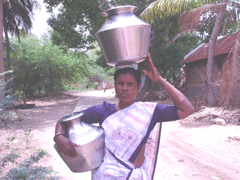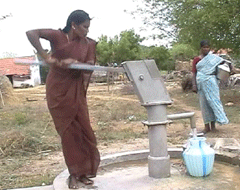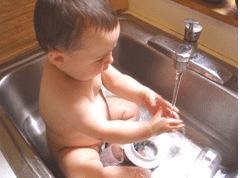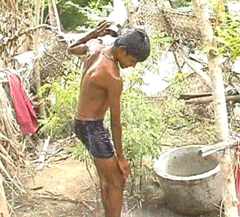Water Diaries
Air Date: Week of August 17, 2007

(Courtesy of S. Bhaskar)
A billion people without safe water, twice that many with no sanitation. Figures on the global water crisis can be hard to absorb. So Living on Earth's Jeff Young recorded his daily water use, while a woman in rural India did the same. The result is a sobering glimpse into the global inequities of water and wealth.
Transcript
CURWOOD: Scientists, government officials and activists from 130 countries just wrapped up World Water Week in Stockholm, an effort to bring more attention and resources to what they call a global water crisis. More than a billion people around the world do not have safe drinking water; another two-and-a-half billion lack basic sanitation.
Living on Earth decided to take a look at how we use water - here and in another part of the world. So, we asked our Washington correspondent Jeff Young to keep a diary of his water use for a day. And we asked a woman in a small village in southern India to do the same. The result is this day in the life, measured out in water.
[WATER POURING INTO KETTLE]
YOUNG: So this is how the day starts for me. Gotta get some coffee and jumpstart my morning.
[SOUND OF TOILET FLUSH AND TOOTH BRUSHING]
YOUNG: Brushing teeth, about half a gallon.
[SOUND SHOWER CURTAIN AND WATER]
YOUNG: So about eight minutes in the shower, three gallons for every flush of the toilet, a pint of water for coffee, I’m already up to 23 gallons of water and my day’s just getting started. The day starts quite differently 10 time zones away in the Indian state of Tamil Nadu. That’s where Mrs. Marhudhambal lives.
[SHOWER SOUNDS FADE TO VILLAGE SOUNDS]
[MARHUDHAMBAL UNDER TRANSLATOR]
TRANSLATOR: I live in Sukkampatti village in the state of Tamil Nadu with my husband and two children. First thing in the morning when we go to the bathroom we need water for that, to clean up. We have no bathroom. We must go to a field to defecate.
[SOUNDS OF CLEANING POTS AND PANS]
TRANSLATOR: I get up at five to get water for cooking and cleaning. Next, I splash water around the entrance to the house to keep down the dust. I really need two bowls of water for that but I don’t have enough, so I use only one.

Mrs. Marudhambal pumps water. (Courtesy of S. Bhaskar)
TRANSLATOR: There is a water tank about a half-mile away. We fill our pots with water and carry them back. But we have to gather all the water before dark. There is no lighting and there are poisonous snakes and stinging insects along the path. When the electricity is out the water tank can’t be filled. Sometimes it will be four days with no water in the tank. When that happens I have to ride my bicycle about a mile to another water source.
[HAND PUMP SQEAKING]
TRANSLATOR: This hand pump water is like seawater. But we have no other choice.
[KA-CLUNK! OF BOTTLE IN SODA MACHINE]
YOUNG: One of the first things I see when I walk into the office building here at the capitol is this vending machine selling bottled water. So here’s a question: If I’m willing to plunk down a buck 25 for what is—let’s face it—repackaged tap water, well how much of my tax money should I be willing to spend to help out people like Mrs. Marhudhambal around the world? It’s a question some people here on Capitol Hill are starting to ask.
BLUMENAUER: We are facing a global crisis with lack of sanitation and safe drinking water when we are a country that spends upwards of 20 billion dollars a year on bottled water.
YOUNG: That’s Oregon Democratic Representative Earl Blumenauer. The number he uses is at the high end of estimates of water sales. Industry figures point to about 15 billion a year, retail. But Blumenauer’s point is this: 15 billion for bottled water is 250 times what the government put toward global water development. Blumenauer’s pushing for more money for the Safe Water for the Poor Act. Congress passed that law two years ago but failed to provide much funding.
BLUMENAUER: It is a drop in the bucket. We ended up last year with something like 60 million dollars for this global need and less than 10 million for all of sub-Saharan Africa. It’s going to require hundreds of millions of dollars added to this effort on an annual basis. But this is within our capacity.

This is how Mrs. Marudhambal spends much of her day--carrying pots of water a half mile or more. All her family's water--drinking, cooking, bathing, even watering livestock--arrives this way. Global water agencies estimate that some people in the developing world spend a quarter of their waking hours in pursuit of water. (Courtesy of: S. Bhaskar)
YOUNG: The Water for the Poor Act directs the State Department to make water and sanitation development part of U.S. foreign policy. Gary White at the non-profit group Water Partners International says the money doesn’t still flow to those most in need.
WHITE: You know, our foreign policy isn’t really focused right now on helping people out of poverty now as much as it is on other goals.
YOUNG: White says water funding is siphoned away to expensive projects in Afghanistan, Iraq and around the Middle East, areas where the U.S. wants to counter terrorism. White argues for a policy that also emphasizes getting water to the neediest.
WHITE: If the United States had a Marshall plan for water supply and said ‘we’re going to get water to a billion people around the world,’ and that became a centerpiece of our foreign policy you can imagine the goodwill that the United States would have. I think it would be hard to imagine a world that would have a critical mass of people wanting to attack us if we had taken on such a great goal for humanity.
[SOUNDS OF A DISHWASHER]
YOUNG: So back home for a few chores. According to the owners manual the dishwasher uses seven gallons per wash cycle.
[WATERING CAN]
YOUNG: These basils look thirsty watering the plants about another six gallons.
[BABY SQUEALING]

Jeff doesn't worry much about his baby, Hazel, getting sick from the
water... (Jeff Young)
YOUNG: Bathtime for baby: not a lot of water used but a moment to think about water quality rather instead of the quantities. D.C.’s water did have some lead in it for a while we used filters, we still use a filter, that takes care of that. But we don’t give a second thought as to whether contact with water is going to make our baby sick. That’s a real luxury elsewhere around the world. In fact, the United Nations figures tell us that diseases caused by the exposure to dirty water is the second leading cause of childhood death around he world—4900 children will die today as a result of being exposed to dirty water.

Waterborne illness is a constant concern for Mrs. Marudhambal as her son bathes outdoors. U.N. statistics say contact with dirty water leads to 4,900 childhood deaths around the world every day.
(Courtesy of S. Bhaskar)
[VILLAGE SOUNDS]
TRANSLATOR: We took water samples from two wells and the hand pump we use. We took the water to the local officials. After tasting it they said the water is not fit to drink. They wondered how anyone drinking it could survive.
[CLOTHES WASHING BY HAND]
TRANSLATOR: For washing clothes I need 10 pots of water if I need the clothes to be very clean. The farmers won’t allow us to wash or to clean clothes at the water well.
They think the soap will pollute the water they need for crops. So we have to carry the water home for washing clothes.
[WATER SPLASHING, BOY BATHING OUTDOORS]
TRANSLATOR: We need to bathe every day. I need three pots of water for each person. That’s a total of 12 pots of water for bathing alone.
[FOUNTAIN SOUNDS]
YOUNG: I thought it would be a fitting way to wrap up this day with a little evening stroll around some of the fountains here on the capitol grounds.
YOUNG: So how do we compare at the end of the day, Mrs. Marudhambal and I? There was a bit of guesswork involved here, I’ve got to admit, but I used about 95 gallons of water. The average American uses somewhere between 100 and 160 gallons a day, depending on what activities you include. Mrs. Marudhambal’s family used a little under 30 gallons of water per person. But what struck me about her was not so much the amount of water used but the time and energy spent getting it. Imagine the other things she could be doing with her time and energy.
[FOUNTAIN SOUNDS]
YOUNG: We take this resource so much for granted, water is almost invisible to us. And the people around the world who go without water, well they’re pretty much invisible to us, too. It’s kind of like water itself. You see through it until the light catches it just right. Then you see yourself reflected in it.
For Living on Earth I’m Jeff Young in Washington.
[MUSIC: Olov Johansson “Stormyren (The Big Bog) from ‘Storsvarten’ (Drone Music AB – 1998, East Side, Inc. - 1998)]
CURWOOD: Thanks to Shobila Kaligounder, the Tamil Sangam, Global Water Challenge, and Water Partners International for their help in translating our water diary from India.
[MUSIC CONTINUES]
Links
American Waterworks Assoc. has a nifty page that helps you calculate your water diary
Water Partners International is a good place to explore global water needs
Living on Earth wants to hear from you!
Living on Earth
62 Calef Highway, Suite 212
Lee, NH 03861
Telephone: 617-287-4121
E-mail: comments@loe.org
Newsletter [Click here]
Donate to Living on Earth!
Living on Earth is an independent media program and relies entirely on contributions from listeners and institutions supporting public service. Please donate now to preserve an independent environmental voice.
NewsletterLiving on Earth offers a weekly delivery of the show's rundown to your mailbox. Sign up for our newsletter today!
 Sailors For The Sea: Be the change you want to sea.
Sailors For The Sea: Be the change you want to sea.
 The Grantham Foundation for the Protection of the Environment: Committed to protecting and improving the health of the global environment.
The Grantham Foundation for the Protection of the Environment: Committed to protecting and improving the health of the global environment.
 Contribute to Living on Earth and receive, as our gift to you, an archival print of one of Mark Seth Lender's extraordinary wildlife photographs. Follow the link to see Mark's current collection of photographs.
Contribute to Living on Earth and receive, as our gift to you, an archival print of one of Mark Seth Lender's extraordinary wildlife photographs. Follow the link to see Mark's current collection of photographs.
 Buy a signed copy of Mark Seth Lender's book Smeagull the Seagull & support Living on Earth
Buy a signed copy of Mark Seth Lender's book Smeagull the Seagull & support Living on Earth

